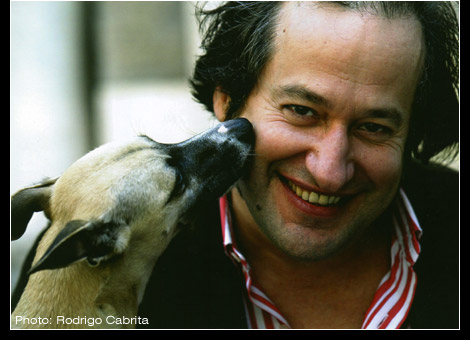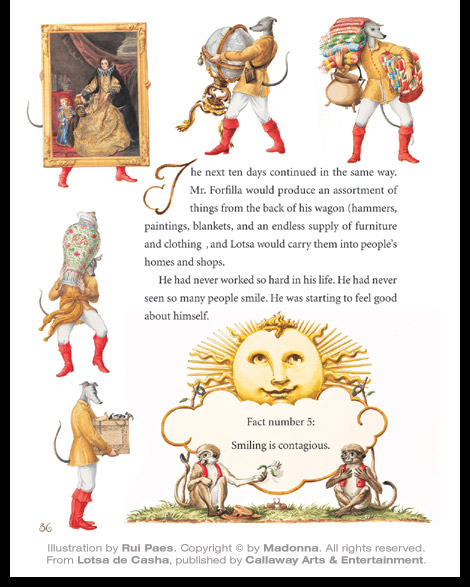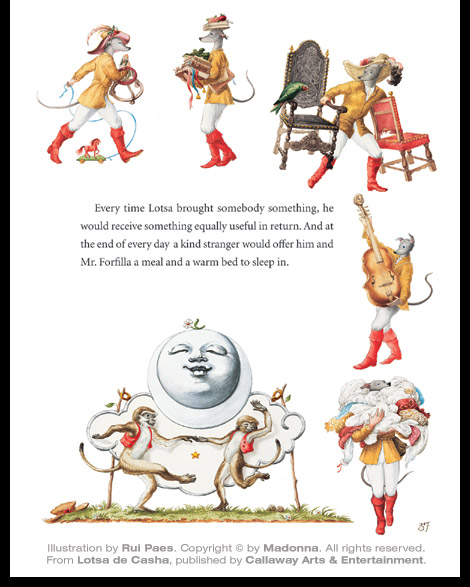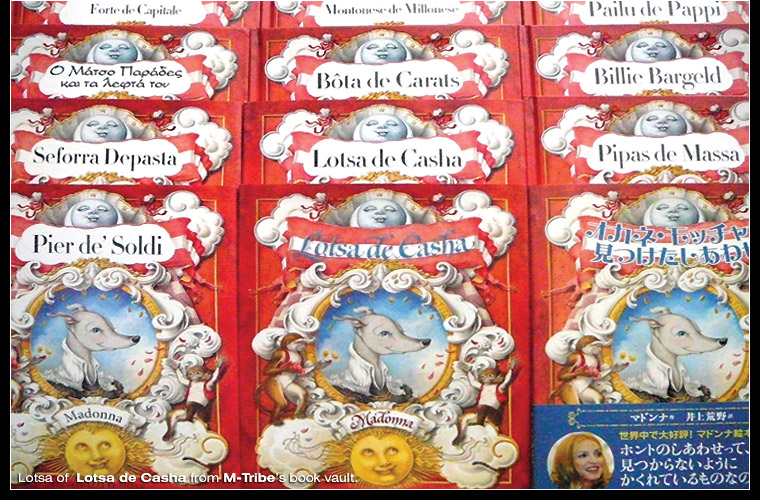| |
| |
| |
MadonnaTribe has had the pleasure to meet
artist and illustrator Rui Paes who contributed
his talent to Lotsa De Casha, the fifth children's
book by Madonna. We spoke with Mr
Paes about the creative process behind the beautiful
Losta illustrations, his background and his future projects,
for this revealing exclusive interview. Mr Paes
also explains for the first time in detail the concept and
meaning of his Madonna portrait, named The Madonna
Of The Five Senses. And now... MadonnaTribe
meets Rui Paes.
|
|
 |
MadonnaTribe: Hi Mr. Paes,
welcome to Madonna Tribe, it's a pleasure having you here
with us. Madonna's fans had the chance to get in touch with
your art thanks to her "Lotsa de Casha" children's
book. When did you start the drawing process for Lotsa De
Casha?
Rui Paes: Immediately after I was contacted
by the publishers it was agreed that I would produce a series
of sketches to define and assert different aspects of the
various characters. This was a very helpful process inasmuch
as it allowed me to establish the levels of interaction
of those same characters within their significance in the
narrative. I saw them as symbols of very specific concepts
that I was more than happy to embrace and convey myself.
From then onwards and having, basically, fallen in love
with the story the whole process became quite feverish.
I knew the story by heart (having read it over a hundred
times) and would go through it in my mind, in bed, every
night, peeling off layers and discovering hidden meanings
and subtexts. These I tried to bring out in terms of imagery.
|
|
| |
It became pretty much a full time job, not by choice but out
of pure empathy, and one that I cherished greatly.
MT: "Lotsa de Casha" was your first
illustrated book for children. How have you been contacted
for the job? Did you happen to submit a portfolio to Callaway
and Madonna, and if so, which images did you choose?
RP: The telephone call came soon after having
answered an e-mail from the publishers as a consequence of
an article published in "The New York Times Magazine"
regarding a Singerie I had painted for the entrance hall of
a castle in Norway.
Having established that I would honour the secrecy of the
project I was then sent the full version of the story and
went on to organize a small portfolio of images that would
substantiate and broaden the scope of possibilities. I chose
images of my mural work, etc., and some of my studio work
(which is much darker in feel).
Among the selected images, there was a series of photographs
of a velvet tablecloth, commissioned by ‘Colefax and
Fowler', which I had painted for one of their clients in Chicago.
It was based on the anthropomorphic animals that were part
of the French 19th Cent. draughtsman Grandville's cartoons
on social criticism. The publishers liked these very much
and the idea became a possible starting point to pursue. We
both agreed, immediately, that this concept would enhance
the fable like quality of the story.
MT: Do you remember which was your
first reaction at the idea of Madonna as an author of stories
for children? This was a move that surprised even some of
her die-hard fans...
RP: I was very cool
about it, to be honest.
As well as an extremely professional artist, Madonna is, also,
a Mother.
Being a parent, myself, I remember spending many hours throughout
my son's childhood, telling him stories that I would invent
for him or that we would create together, mostly accompanied
by drawings made up on the spot. Sometimes the drawings themselves
would be the starting point for the story.
Madonna's work has shaped many people's
lives, opening up new horizons and bringing hope of dreams
fulfilled to many, and I am sure she takes her motherhood
very seriously.
|
|
| |
Perhaps she had not only her children in mind, when she decided
to pursue the idea of writing and publishing children's stories,
but also the possibility of bringing some joy and wonderment
to every other child worldwide.
MT: And what do you think of her style and of the
message she carries through her books?
RP: I find the quality of her narrative very
close to the one in stories that Oscar Wilde wrote for his
own children- very direct and, yet, richly filled with poetic
and humane elements that greatly touch vital, sensitive points
in values of conduct. There is no predictability in her stories.
Situations are clear and to the point and, yet, they linger
in one's mind and heart because they engage the reader at
its most intimate level - how we relate to each other, to
ourselves and to that which we don't understand - which is,
basically, what makes us spiritual beings. These are not stories
for prejudiced people, even if those would gain, greatly,
by reading them.
MT: How long did it
take you to work on the book's illustrations?
RP: The whole process took the best part of two years
with the majority of the final work, the last leg, being concentrated
in the final twelve months. I can't recall exactly. I know,
however, that I had a daily schedule of 12 to 14 hours a day,
every day of the week, uninterruptedly, in those last twelve
months. The intensity of the work was such that, for a while,
I developed serious back problems. To see to that the publishers,
very kindly, offered me an Aeron chair - a life saver - and
Madonna, very sweetly, sent me her private masseuse for a
shiatsu session that improved things a great deal and restored
my well-being enormously.
|
|
| |
MT: How is your
typical process like? And was working on "Lotsa"
somehow different?
RP:
When I paint, for the open market or for an
exhibition, I like to work from memory which, I find, serves
my idiosyncrasies better and allows me greater freedom. Especially
when I am working with the human figure. That is not to say
that I don't research continuously both before and after I
have established the main points of the composition. Because
of the set of concerns that occupy my thoughts when I am at
my easel, this work turns out to be, as I said before, substantially
‘darker' in feel.
I like symbols, things that, one way or another, operate at
a subliminal level - small notes on the notion that we are
all part of the same large collective.
The murals I paint try to respect the original trace of the
building and add to it by making that space feel more important
in terms of architecture. Again, here, research is of the
essence. And the ‘animated' elements introduced in the
mural scenes have a subtle, understated presence and humour
that should not disrupt the whole.
With "Lotsa" the major difference was that, somehow,
I had a script. The narrative worked as a guideline for the
various compositions but was also very open. This allowed
me to introduce a whole series of ‘extras' as small
incidental characters that populate the book throughout. These
sustain the actions of the main characters, visually, and
give a more palpable substance to the different atmospheres.
One of the main elements in most narratives is time. And in
this particular story the passage of time, the sense of a
journey taking place, is most important. Hence the presence
of the Sun and the phases of the Moon in the front and back
cover of the book, and in the title page, which reflect not
only the succession of days but, also, the changes occurring
with "Lotsa" as a human being. I had great fun.
|
|
 |
| |
MT:
Which kind of feedback and interaction you had with Madonna
and the book's publishers during the process?
RP: Madonna
is possessed of tremendous visual awareness and I was very
lucky that she liked what I proposed. She could see, immediately,
the potential of the various sketches I presented and was
a constant support with her positive reaction. Her sense of
humour and openness were also very important.
When I was designing the interior of the Wise Old Man's house
(the Owl), I thought that if he had a wife he should also
have a family.
As a child, I remember spending many hours on my own, drawing
and painting sprawled on the floor at my parents' house in
Africa. So I called Madonna and asked her if she could send
me some drawings of her children. I got those and used them
in that same scene, in the kitchen of the Wise Old Man, copying
them carefully onto those tiny sheets of paper that are spread
on the floor of the kitchen, as if they had been made by the
Owl's children.
In that same scene, in the kitchen, I introduced a small family
of hedgehogs, happily eating bits of bread on the floor. Having
spent some time in Italy I was able to learn Italian and the
word for ‘hedgehog' is riccio with the plural standing
as ricci which sounds like ‘Ritchie' - a little clue
to relate to Madonna who was also the inspiration for the
image of Mrs. Owl with the bowl of spaghetti.
Until Madonna decided to give me a ring, all contacts were
made via the publishers and they were very good in reporting
back to me her reactions to my work, which kept me going.
They were also quite good in accommodating the breaks in the
text that I suggested in order to pace the narrative with
the illustrations, what I call the hot points in the story,
and in mediating the early contacts with Madonna when we were
establishing all the main visual elements and aspects of the
story.
MT: Was it harder to paint a main
character that is not human?
RP: Not at all. I did try to imbue the different
animals' faces with human qualities and emotions. And the
fact that those same faces sit on human bodies allowed me
to add to their "inner world" a whole set of expressions
that hands and body posture also convey. Animals have always
been part of my reality both as a child and, now, as an adult.
They also take a very important role in my work as a muralist
or at my easel, in my studio.
|
|
 
|
MT:
Are some of the animals you used in the book a sort of memory
of your childhood days in Mozambique?
RP: Having been born in Africa, the contact
with all sorts of different animals was much easier and immediate.
Animals have always puzzled me. They seem to have a very firm
notion of their reason as living beings. As a child I had
quite a few that lived close to me and I remember a sweet
little squirrel that I use to carry inside my shirt almost
everywhere. But, of all, monkeys were the most intriguing
- their hands were so animated and expressive - and when you
catch their eye you really expect to hear a little voice telling
you something funny or, sometimes, quite profound. I was very
lucky to have been able to bring all of this into the book.
MT: The story of "Lotsa" has a very specific
time setting and there's a strong presence of architectural
elements from the late Renaissance and early Baroque era.
Where did you get your inspiration from? I understand Madonna
herself suggested a visit to the beautiful Italian city of
Siena, and that you also stayed for a while in Genoa...
RP: The first line in the story is "Long,
long ago…" so I had to decide how far back that
notion would allow me to go, in order that everything would
make sense. Especially when you know that, within the narrative,
you will have to travel further back in time, so to speak,
when "Lotsa" visits the ancient city.
The choices were between Rome and Siena. In the end, we both
agreed, Siena should become that ancient city - Madonna loves
it and, I admit, I do, too. It has a very human scale and
its sobriety is, nonetheless, laden with great pulsating energy.
And the striped buildings, a device reserved for the nobility
and the church, are extremely beautiful.
Once the various aspects of the time/space relationship were
established I went on into a very fastidious research process.
It was vital that a sense of reality should be brought into
the construction of the images both for the reader's sake
and mine. "Lotsa" had to be so present and well
rooted in its surrounds as to have existed in fact.
During the early stages of the book I was living in Genoa
in a magnificent palazzo belonging to some friends from where
I took greatly as a source of inspiration. It dates back to
the 17th Century and it aroused Rubens interest when he first
arrived in Italy and drew a whole set of facades of Genoese
palaces.
In fact, the painting that "Lotsa" carries in one
of the images of the book is actually a Van Dyck that belongs
to the collection of the house and that I copied quietly -
"La Dama d'Oro" or "The Golden Lady".
I was told, then, that the gold used in the exquisite embroidery
of her dress would be enough to buy a ship. I still believe
it.
And I looked extensively at paintings and drawings of the
period.
In the long hours spent at my drawing table I listened to
Baroque music, constantly, to insulate myself from the outside
(when I was tired I would put some Madonna on, to give me
a boost). Also, the work of the Dutch painters who travelled
through Italy at the time, making wonderful notes of the landscape
and the moods in its light, and the clear prints of Dutch
interiors by Rembrandt, were terribly important. The original
of the chair that "Lotsa" admires so intently is
part of the collection of English furniture at the ‘Victoria
and Albert Museum', in London, except that I changed its colour
from purple to sunny yellow. I got hold of everything I could,
from old auction house catalogues to old prints and pieces
of fabric.
The two red hazelnuts tied with a yellow ribbon I picked from
my garden, in the country.
|
|
| |
MT: Do you have
an illustration from "Lotsa" you cherish the most?
RP: In time, the
one that has grown on me the most is "Lotsa forlorn".
"Lotsa" stands totally defenceless in his sadness,
soon after he was attacked and robbed by the false-beggar
monkeys. In the middle of two towers in the distance he is
completely taken up with pain and very much alone, apart from
the two snails (a symbol of change and renewal) that follow
him throughout the narrative and which he never notices. The
clouds and the stones cry with him but he doesn't notice that
either.
I have sold quite a few of the original watercolours from
the book but this one I am keeping for myself.
|
|
| |
MT:
And is there any that did not end up being used in the book?
RP: Yes, basically, a couple of them which I chose
to replace.
The first title page, which I changed since I found it a bit
hard and too decorative. Also
an initial image of "Mr. Forfilla" holding the lantern
when he meets "Lotsa" after the mugging. It had
his back to the viewer and his profile was in silhouette against
the light of the lantern.
It was quite mysterious and "Mr. Forfilla" resembled
very much the Minotaur of the ancient Greek myths which was
fine but I decided to show him frontally, with a more frank
and clear face. That decision also helped the balance of the
two pages since opposite him, also facing the viewer, "Lotsa",
still crying, gesticulates his determination to ‘work
for nobody'.
MT: Mr. Paes,
would you say this experience working with Madonna and Callaway
has changed something in your career? Which kind of feedback
did you get, from a professional point of view?
RP:
It did bring my work to the attention of a much broader audience.
The book was published in around 110 countries and, all going
well, it will be cherished by the children who own it and
the future generations after them.
I went from being an artist known by a select group of collectors
to become a much more reachable one.
And that circumstance did, also, renew the interest in my
work in general.
|
|
|
But
working with Madonna can also be a double edged sword - there
are people who still don't understand her dimension as an
artist - and I felt, at times, that I was being looked at
with suspicion, especially by the contemporary art world clique,
or it could be just plain jealousy.
MT: We have heard that you completed a portrait of
Madonna in the style of the book's illustrations that wasn't
used in the end. Can you tell us more about that?
RP:
Yes, "The Madonna of the Five Senses",
an oil on canvas which is now part of Madonna' art collection.
It portrays Madonna wearing a 17th Century shepherdess straw
hat, lined in purple silk and ornate with poppies (a symbol
of love), wheat husks (for bread) and a pheasant tail feather
(for openness). This same hat was sported by "Lotsa"
in one of the images in the book.
She holds a partly peeled pomegranate in one hand (for Fertility)
signifying the sense of Taste.
Her other hand holds one of the vervet monkeys from the "Facts",
in the story, signifying the sense of Touch.
Grappling on Madonna's back, the second monkey from the "Facts"
holds a pink English rose in one hand and a small round mirror
in the other hand. Trough its wrist a small golden bell hanging
from a blue ribbon, signifying the sense of Hearing.
The first monkey's face (the one held by Madonna) looks through
the mirror, straight into the viewers eyes, signifying the
sense of Sight.
Coming from the lower left side corner, a "blue"
greyhound's head ("Lotsa") sniffs the rose on Madonna's
shoulder, signifying the sense of Smell.
She also wears a red ribbon on her left wrist (for the Kabbalah)
from which hangs a small golden disc with the Latin inscription
"Musica docet Amore" which translates roughly as
"Music teaches Love".
In order to do the portrait I was sent around over 60 or 80
photographs of Madonna. From those I selected a dozen that
I used as a base to building her portrait. I decided not to
do a straight copy of one of the photographs as I find that
rather dull.
And I chose to paint her in natural colours, without any make-up
as such, to try and bring out her inner beauty.
|
|
 |
|
MT:
Lotsa de Casha's name was adapted in each country the book
was released.
It became for example, Pier de' Soldi in Italy, Pipas de
Massa in Portugal and Enrico de Prata in Brazil.
What do you think about this interesting marketing move?
RP:
It made absolute sense. It was very important
to get an immediate connection between the character's name
and the basic personality trait it conveys. A small thing
partially lost in most adaptations was the Italianate resonance
that the name has in English.
I chose the version of the name that was used for the Portuguese
translation. It means, basically, "Barrels of Dough"
and is a not an uncommon expression applied when referring
to something very expensive - ‘it costs a barrel of
dough', or for somebody who has made a lot of money -‘he
has made a barrel of dough'.
So far, I have managed to collect 10 different translations
of "Lotsa" and it is great fun to say the names
aloud in the various languages.
MT: Which are your latest projects, and
what is coming next?
RP: At the moment
I am illustrating a book for the Portuguese Opera, the "Teatro
Nacional de Sao Carlos", in Lisbon, also for children
and have two other books in the pipeline.
There is also a show of the remaining "Lotsa"
originals lined up for the Chipping Norton Theatre, near
Oxford, in early May, this year, and another show for 2009,
for which I am producing new work.
And I am still wading through the burocracy of implementing
the creation of a library in my home town, in Mozambique,
where my parents left an important legacy.
MT:
Thanks so much Rui, it was very nice to meet you. All
the best for everything that's coming next.
|
|
 |
| |
The
Madonna Tribe team would like to thank Mr. Rui Paes
for the chance to share some quality time with our
readers.
Special thanks to our friend Axel Potoms
for his help and assistance. Illustrations by Rui Paes. Copyright
© 2005 by Madonna. All rights reserved. From Lotsa de
Casha, published by Callaway Arts & Entertainment.
"The Madonna of the Five Senses" by Rui Paes, courtesy
of the author. Photograph of Rui Paes by Rodrigo Cabrita.
This interview © 2007 MadonnaTribe.
For more about "Lotsa de Casha" also check our interview
with Valeria Raimondi, Editor of Feltrinelli's children's
book collection "Kids", about the unique experience
of translating these stories by Madonna into the language
of her Ciccone ancestors.
|
|
 Your favourite stop for latest Madonna
news, previews, articles, exclusive interviews, magazine and
cover scans,
Your favourite stop for latest Madonna
news, previews, articles, exclusive interviews, magazine and
cover scans,
picture galleries, and Community Forum. This site is not endorsed
by Madonna or Warner Bros Records.
From fans to fans, © 2003-2007 Madonna Tribe
|
|
 |
|
|
